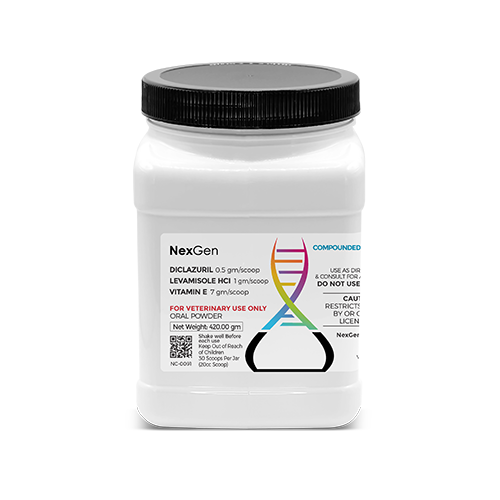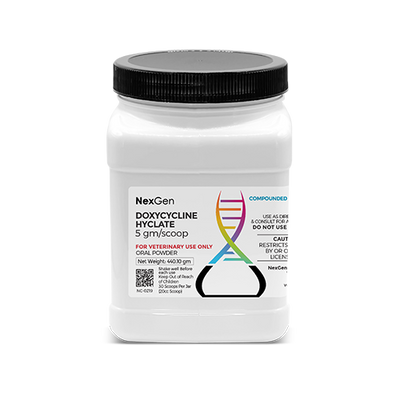
Diclazuril 500 mg/scoop + Levamisole HCl 1 gm/scoop + Elevate 7 gm/scoop, Oral Powder, 30 Scoops (20cc Scoop)
Login for pricing
- Brand
- Mixlab
- SKU:
- NC-0091
- Product Type:
- Powder
- Size:
- 32oz
- Administration:
- Oral
- Scoops Per Container:
- 30
- Scoop Size:
- 20cc
Equine Protozoal Myeloencephalitis (EPM) is an equine neurologic disease caused by the protozoan Sarcocystis neurona. The bacterium infects horses when they ingest the organism in feed or water that has been contaminated with faces from the opossum (Didelphis virginiana). The opossum is the definitive host for S. neurona; the horse is what’s known as a “dead end” host for the organism, because once infected, they are unable to pass the disease on to other horses (or any other animal).1 Some cases of EPM are attributable to the protozoan N. hughesi.
Since the opossum is indigenous to the Americas, the occurrence of EPM is restricted to North, South and Central America. It is estimated that more than 50% of all horses in the United States may have been exposed to the organism that causes EPM, although only an estimated 1% of those exposed will develop clinical disease.
EPM: Disease and Diagnosis
Once a horse has ingested the S. neurona organism, it penetrates the gastrointestinal tract and then the bloodstream, from which it can invade the central nervous system. Clinical signs of EPM can vary depending on the level and progression of the infection. These signs may be gradual, or acute and severe. Usually horses with clinical EPM will present with asymmetric hindlimb paresis (weakness) and muscle atrophy.1 Occasionally, initial signs may be related to a cranial nerve deficit or a focal brain lesion. Most commonly, veterinarians suspect EPM when a horse presents with evidence of spinal cord disease.1,2
Since no test in the live horse is currently considered definitive, a definitive diagnosis of EPM relies on postmortem examination of neural tissue. Therefore, EPM is diagnosed based on a combination of a thorough neurologic examination, and evaluation of serum and/or cerebrospinal fluid (CSF) for the presence of antibodies to S. neurona and/or N. hughesi.2It is important to note that a positive blood test only determines that the horse has been exposed to the parasite and does not mean that the horse will develop clinical signs or that any neurological deficits are being caused by protozoal parasites.
EPM Treatment
Treatment to control EPM infection usually includes an FDA-approved anticoccidial drug such as ponazuril, diclazuril or sulfadiazine. Other adjunctive treatments may be provided based on the severity of the clinical signs and attendant complications. NSAIDs can be given to more severely affected horses during early antiprotozoal treatment to prevent the worsening of neurological deficits.2 In diagnosed horses that show brain involvement, or are in danger of falling, a short course of corticosteroids and dimethyl sulfoxide may reduce the inflammatory response.1
Vitamin E supplementation is also frequently recommended due to its antioxidant properties. Horses with severe, acute neurologic deficits may also be treated initially with flunixin (Banamine), phenylbutazone (Bute), or DMSO.1,2
Elevate Powder was developed to provide a bioavailable source of vitamin E to horses. Horses cannot synthesize Vitamin E, therefore it must be supplied by other means. Vitamin E is a powerful antioxidant which cellular damage caused by normal internal and external stressors. It helps to maintain healthy muscle and nerve function while supporting a healthy immune system.
Where to buy Diclazuril + Levamisole + Elevate Powder
Diclazuril + Levamisole + Elevate Powder is available in the U.S. through veterinary custom compounding companies.
Please consult your veterinarian prior to beginning any treatment regimen.
FOR RX ONLY: A valid prescription from a licensed veterinarian is required for dispensing this medication.
1Reed, S M et al. Equine Protozoal Myeloencephalitis: An Updated Consensus Statement with a Focus on Parasite Biology, Diagnosis, Treatment, and Prevention. Journal of veterinary internal medicine vol. 30,2 (2016): 491-502. doi:10.1111/jvim.13834.
2Dubey, J.P. et. al. (2001). A review of Sarcocystis neurona and equine protozoal myeloencephalitis (EPM). Veterinary parasitology. 95. 89-131. 10.1016/S0304-4017(00)00384-8.
















